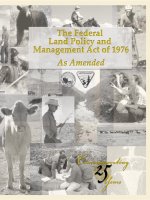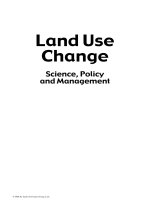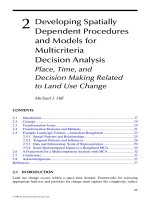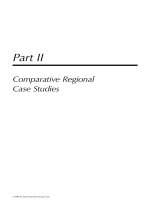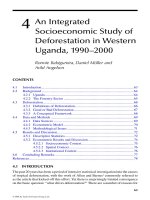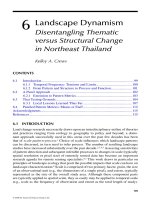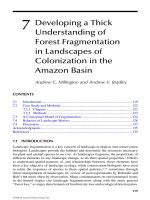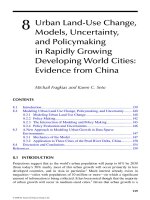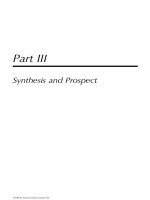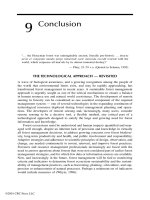Land Use Change: Science, Policy and Management - Chapter 9 (end) potx
Bạn đang xem bản rút gọn của tài liệu. Xem và tải ngay bản đầy đủ của tài liệu tại đây (236.35 KB, 17 trang )
Part III
Synthesis and Prospect
© 2008 by Taylor & Francis Group, LLC
163
9
Synthesis, Comparative
Analysis, and Prospect
Michael J. Hill and Richard J. Aspinall
CONTENTS
9.1 Introduction 163
9.2 A Summation of the Chapters 164
9.3 Overall Messages 169
9.3.1 Realizing the Full Potential from Remote Sensing 169
9.3.2 Application of Integrated Methods 171
9.3.3 Placing Analysis in Context 173
9.4 Conclusions 174
References 176
9.1 INTRODUCTION
This book has examined the issue of integrated analysis of spatial structure and
spatiotemporal processes related to land use change in terrestrial coupled human
environment systems. The consequences of land use change have been to transform
alargeproportionofthelandsurfaceoftheEarth,andthesechangesareinuenc-
ing the global carbon cycle, regional climate, water quality and distribution, and
biodiversity through habitat loss.
1
The book presents a number of case studies that
include urban, wilderness, wet tropical forest, and arid desert-like environments,
human population densities from high to very low, and those that demonstrate both
direct and indirect human inuences (Table 9.1). The case studies include several that
focusonanalysisofclearingoftropicalforestenvironments(Chapters4,5,6,and7;
Table 9.1). These are environments of high signicance to global carbon stocks, bio-
diversity, regional climate, and African, Asian, and South American economies.
2,3
However,bothintensiveagriculturallands(Chapter3;Table9.1)andextensivegraz-
inglands(Chapter2;Table9.1)arealsocovered,whilespecicattentionispaidto
the late 20th-century phenomenon of the rise of megacities (Chapter 8; Table 9.1).
These case studies and other literature
1,2,3,4,5
suggest that a trade-off approach
isprobablytheonlypragmaticoptiontomoderatingtheimpactofhumansonthe
terrestrialsystem.Thepaceofmodicationofthelandsurfaceshowsnosignof
slowingwhilehumansmodifytheirapproachesinresponsetochangesindemand
andpriceforproductandtoavoiddetectionandcontrol.
6
In this chapter we briey
summarize the main points from each chapter and then examine in turn the main
© 2008 by Taylor & Francis Group, LLC
164 Land Use Change: Science, Policy and Management
messagesdescribedaboveandlookatthepotentialfordeliveryofsocietalbenet
fromaholisticunderstandingof,andapproachto,landusechange.
9.2 ASUMMATIONOFTHE CHAPTERS
Theapproachinthisbookcanbesummarizedintermsoftheproblemcontext,meth-
odological approaches, and geographical-system context (Table 9.1). The science
context for the theme of the book has been outlined in Chapter 1. Five basic science
questionswereidentied:dynamicsofchangeinspaceandtime;integrationoffeed
-
backs between landscape, climate, socioeconomic and ecological systems; resilience,
TABLE 9.1
A Summary of the Key Issues, Contexts, and Methods Examined in
Each Chapter of the Book
Chapter Problem context
Methodological
approach(es)
Geographical-system
context
1. Aspinall Technical overview of
dynamics, scale,
accuracy, uncertainty,
pattern and process
Models—conceptual, GIS,
RS, CA, MAS, simulation,
statistical, empirical,
visualization,
space-time scaling
International research
frameworks—GLP,
bio-complexity, etc.
2. Hill Transformation of
spatiotemporal data
and relationships to
simple indexes
Integration of time-series
analysis, spatial analysis,
numerical and
heuristic methods
Savanna and grassland
biomes/livestock
as agents
3. Byron/Lesslie Social surveys of
attitudes to natural
resource management
issues
Assignment of relationships
between landholder
perception and opinion and
biophysical features or
management practices
Rural eastern Australia
4. Babigumira,
Müller, and
Angelsen
Tropical forest clearing Spatially explicit logistic
models
African tropical forests
5. Etterand
McAlpine
Tropical forest clearing Regression tree and
regression models of
deforestation/regeneration
Amazonian
tropical forest
6. Crews-Meyer Fragmentation of forest Patch panel metrics—
pixel-patch histories
Thailand tropical forest
and regrowth
7. Millington
and Bradley
Tropical forest clearing Spatial imprint of cadastral
grids; differential behavior
of fragmentation metrics
as forest cover declines
Amazonian tropical
forest
8. Fragkias and
Seto
Urban expansion/
megacities
Multiple logistic regression,
pseudo-Bayesian model
averaging to get predicted
probabilities of change
Cities of Pearl River
Delta—Shenshen,
Guangzhou, and
Foshan, China
© 2008 by Taylor & Francis Group, LLC
Synthesis, Comparative Analysis, and Prospect 165
vulnerability,andadaptabilityofcoupledhumanandnaturalsystems;scaleissues;
and accuracy and uncertainty issues. Approaches incorporating all of these consider-
ationscanbegroupedunderthegeneralheadingof“models,”butthisincludesadiver-
sity of types from conceptual through to empirical (Table 9.1). A broader context for
incorporating the different elements of case studies of land use change is to consider
a range of integrating frameworks (Figure 9.1). These include the analytical struc-
ture for the Global Land Project
7
; the Human Ecosystem Model
8
;theverygeneral
frameworkofexplicitfocusonlinkagesbetweenthedynamicsofhumanandnatural
systems of the U.S. National Science Foundation Biocomplexity in the Environment
program ( and, with a view
to a more design-oriented approach to landscape change, the Landscape Design
Research Framework.
9
All of these frameworks seek interdisciplinary denition
andfocusonkeyquestionswithinthebroadscopeoflandusechangeandlinksto
management of change in coupled human environment systems.
In Chapter 2, the role of multiple criteria and trade-off analysis is discussed in
the context of methods and approaches for capture and transformation of complex
processes. The chapter proposes simple index-based comparative frameworks in an
interactiveenvironmentthatassistdecisionmaking,butretainthelegacyandcriti
-
cal information content needed for complete appreciation of issues associated with
land use change. The analysis seeks to balance evidence-based science and soft-
systems approaches by integration of hard data with value judgment, public opinion,
and policy and management goals. Temporal analysis is important for entraining
legacy and historical factors in decision making; spatial analysis is important for
appreciation of social, economic, and biophysical impacts outside the boundary of
the directly affected area or geographical location of interest. The approach seeks to
measureandaggregatetheperformanceofalternativeoptions.Itrequiresahighly
systematic and transparent approach to management of information.
The application of methods that address the science issues identied above, and
aggregation of diverse information and data sources into frameworks to assist decision
making,mustbemediatedbythepolicycontextfortheanalysisandmodeling.In
the Introduction we suggested that sustainability science, and specically the tongue
modelofPotschinandHaines-Young,
10
offersacontextand“choicespace”forlinking
science and decision making in policy and management. The case studies provide a
mix of analysis across social, economic, and biophysical perspectives necessary to
develop an understanding of land use change relevant to sustainability.
InChapter3,asocialsurveyapproachisusedtodevelopunderstandingofthe
attitudes and perceptions of rural communities. The work introduces important
methodologicalissuessurroundingrelationshipsbetweenpointsurveydataand
spatially explicit biophysical features of a landscape. The analysis looks at relation
-
shipsbetweenanswerstosurveyquestionsaboutlandmanagementpracticesand
undesirable landscape features based on a distance analysis. This immediately intro-
duces interesting questions about how humans perceive their spatial environment
andhowtheirspatialsensitivitiesandawarenessdiffer.Italsorequiressomeatten-
tiontothelegacyeffectsofhistoricalexperienceandviewsofthelandscape,rooted
inhistoricparadigms,andtheimpactofaspatialviews,norms,andmediaissues
© 2008 by Taylor & Francis Group, LLC
166 Land Use Change: Science, Policy and Management
D
e
c
i
s
i
o
n
M
a
k
i
n
g
E
c
o
s
y
s
t
e
m
s
S
e
r
v
i
c
e
s
D
i
s
t
u
r
b
a
n
c
e
How should the landscape be described?
How does the landscape operate?
Is the current landscape working well?
How might the landscape be altered?
What predictable differences might the
changes causes?
How should the landscape be changed?
Data Information Cultural knowledge
Representation Models
Process Models
Evaluation Models
Change Models
Impact Models
Decision Models
Biogeochemistry
Biodiversity
Water
Air
Soil
Land Use &
Management
Population
Social/Economic
structure
Political/Institutional
regimes
Culture
Technology
E
a
r
t
h
S
y
s
t
e
m
L
a
n
d
S
y
s
t
e
m
s
T2.1
T2.2
T2.4
T3.1
$&
T3.2
#!
T3.3
'%%
T2.3
T1.1
T1.2
T1.3
Natural Cultural
Socio
–
economic
Social
Institutions
Social
Cycles
Social
Order
"
Natural System
Human System
(a)
(b)
(c)
(d)
FIGURE 9.1 (See color insert following p. 132.) A variety of integrating frameworks that seek interdisciplinary denition and focus on key ques-
tions within the broad scope of management of land use change in coupled human environment systems. (a) Analytical framework for the Global Land
ProjectofIGBPandIHDP.(FromGLP,2005,withpermission.)(b)TheHumanEcosystemModel.(FromMachlisetal.,
8
1997, with permission.) (c) The
U.S. National Science Foundation program on Biocomplexity in the Environment ( (d) The
LandscapeDesignResearchFramework.(FromSteinitzetal.,
9
2003,withpermission.)
© 2008 by Taylor & Francis Group, LLC
Synthesis, Comparative Analysis, and Prospect 167
opinions, perceptions, and attitudes.
adriveroflandusechangeisappliedtoassessmentofdeforestationinUganda.
An econometric model (binary—logistic) incorporating explanatory variables that
describesocioeconomic,spatial,andinstitutionalcontextsisusedtoestimatethe
probability of deforestation. The analysis tests a set of hypotheses and seeks to
denereasonsforchange.Thisanalysisisalsointerestingforwhatitdoesnot
include: social survey of attitudes (such as described in the previous chapter) could
addimportantmissingmotivationalinformationonagentbehaviors.Theanalysis
implicitly assumes that motivation will solely be based on maximization of land
rent.Thisisoneofthemainissuesforanalysisofcoupledhumanenvironment
systems:iseconomicreturnafullyadequatedriverforlandusechangeandcon
-
sequent land cover change in most circumstances? An assessment of the rst two
casestudiesmightconcludethateachwouldbenetifbothoftheirapproaches
were combined (i.e., both social survey and econometric modeling were applied).
However, evidence from the other case studies shows that further improvement
might be obtained if more sophisticated spatial and temporal analysis was applied
inconjunctionwithsocialsurveyandeconomicmodeling.
Thenextthreechaptersalladdressdeforestationintropicalforests.InChapter5,
regression tree analysis and logistic regression are applied to analysis of deforesta
-
tionandregeneration.Socialandeconomicprocessesareimportant,asislocaland
regional context, and deforestation follows a temporally explicit trajectory described
byasigmoidalcurve.Patternsarelinkedtoprocessatdifferentscales:national,
regional, and local. Although distances to roads and towns, proximate factors in
the terminology of Geist and Lambin,
11,12
are the best predictors at the national
level, deforestation and regeneration occur at local hot spots at a regional level.
However,atalocallevelmoreexplicitrelationshipsareobtainedwithaccessibility
andsoiltype,sincedeforestationratesarestronglyrelatedtoaspatialmetric—
forest edge density. This provides an example of spatially explicit analysis deriving
a metric with direct meaning in relation to deforestation potential associated with
accessibility. Hence, spatial analysis and calculation of pattern metrics can be used
to generate indicators of likelihood of deforestation at scales in which pattern and
process are directly connected.
This theme of pattern metrics as descriptors or indicators of landscape processes
is continued further in Chapter 6. Here, changes in pattern metrics are analyzed for
landscape patches through a number of time steps using remotely sensed imagery.
In particular the interspersion-juxtaposition index and mean patch size index pro
-
vide measures of fragmentation. These indices give temporal proles for different
land cover classes such as forest, savanna, and rice agriculture. The analysis in the
chapter combines the denition of landscape change in terms of pattern metrics,
forexample,uctuationsthroughtimeintheinterspersionoflanduse/landcover
classes,withassignmentofmeaningtothechangesinpatternmetrics,forexample,
reductioninforestinterspersionasforestpresencedeclineswiththespreadofrice
agriculture.Explanationofregionaldifferencesisbasedonuseofcontextualinfor
-
mation,forexample,proximitytoareasofmilitaryinstabilitydeterringagricultural
© 2008 by Taylor & Francis Group, LLC
in society. The chapter is important because it begins to address spatial analysis of
InChapter4,aneconomicanalysiscenteredontheconceptoflandrentas
168 Land Use Change: Science, Policy and Management
encroachment. This chapter illustrates the application of sophisticated spatiotemporal
analysis combined with the explanatory contextual information, as discussed in
Chapters 1 and 2. The quality of this analysis is highly dependent on the sensitivity
andaccuracyofchangedetectionfromremotesensing.
The assessment of forest fragmentation is continued in Chapter 7 where the
goal is to increase understanding of relationships between road construction and
forestfragmentationinAmazonia.Here,thefocusisonthebehavioroftheagentsof
change rather than on the structure of the land cover. Hence, if Chapter 6 approaches
theissuewithapatterntoprocessorientation,Chapter7isexaminingthesame
issue with a process to pattern orientation.
13
A six-phase conceptual model of the
development of forest fragmentation is described. The approach uses a combina
-
tion of initial context (colonization) and resulting spatial arrangement of distur
-
bance(theroadsystem)asthefoundationtodeveloptheconceptualmodel,which
at each phase has a socio/econo-political context that drives establishment of more
elaborate spatially explicit landscape structure, leading to increased fragmentation.
Patternmetricssuchasmeanpatchsizeandtotaledgelengtharegooddescriptors
of fragmentation, aligning well with the edge metric correlation with deforestation
in Chapter 5, and the interspersion and patch size metric relating to agricultural
expansioninChapter6.However,thegoaltothickenunderstandingofthehuman
dimensionofthechangeleadstothedevelopmentofamodelwithanemphasison
context in the predictive process. This landscape is one of a particular pattern (i.e.,
herringbone clearance pattern), as a result of the colonization context, which estab
-
lishes the spatial skeleton, that is the foundation for the nal fragmentation pattern.
The three chapters that deal with spatial analysis of tropical deforestation and
fragmentation provide a powerful case for combination of spatial analysis and
metrication of spatial patterns in disturbed landscapes; analysis of changes in spatial
metricsthroughtimeasindicatorsofparticularprocessesandparticulartrajecto
-
ries in landscape structure to which economic and biophysical functionality can be
ascribed; and application of detailed analysis of socio/econo-political contexts in
ordertoexplainevolutionofspatialpatternsandregionaldifferencesinpatterns
described by spatial metrics.
ThenalcasestudyinChapter8addressestheissueofrapidurbantransforma
-
tion. A decision theory framework is presented that uses policies, economic data,
aneconomicmodel,andanoptimizationprocedurethatminimizesanobjective
function to produce probability maps of predicted urban expansion. There is no
best or true outcome; the output is a probability surface. The expected rates of
growth for the global megacities—there were already 19 cities with populations in
excess of 10 million in 2000—introduces an urgency to development of predictive
models for planning due to expanded need for energy, sanitation, transport, educa
-
tion, emergency management, health and safety, and clean air and water. Capture of
social, psychological, and economic drivers within a complex spatial context is even
more important. Many cities are already “landscapes of fate” that have most of the
undesirable properties described later in this chapter, and depend upon wealth gener
-
ationandgentricationofpooreroruglierareasforsignicanttransformationback
to a more “desirable” landscape. Therefore, the modeling described in Chapter 8 is of
paramount importance in providing spatially explicit probabilities indicating areas
© 2008 by Taylor & Francis Group, LLC
Synthesis, Comparative Analysis, and Prospect 169
for development that may enable some balance to be attained between desirable and
fateful urban landscapes for human habitation. The urban case requires more atten
-
tion to spatially explicit attribution of sociospatial properties and measures of quality
of built spatial habitats for human activities in order to balance the powerful inu
-
ence of city land values and city-based commerce and nancial enterprise.
14
9.3 OVERALL MESSAGES
TheframeworkoftheGLPprovidesausefultemplatewithinwhichtoexplorethe
key messages arising from both the overview and case study chapters presented in
thisbook.WehaveusedtheelementsfromFigure2oftheGLPSciencePlanand
Implementation Strategy
7
(“The continuum of states resulting from the interactions
betweensocietalandnaturaldynamics”)toillustratethekeyenablingtechnologies,
methods, and approaches needed to provide real societal benet from analysis and
thecasestudiesare:
1. Inordertodetectandaccuratelymeasurechange,remotesensingdataand
associated methodologies must deliver the highest possible information
contentandaccuracyinchangediscrimination.
2. Remotely sensed data should be complemented with detailed household
andothersocioeconomicdatafromeldandcensussurveystoaddress
decision-making processes in detail and gain a better understanding and
capacity to model human and other social and economic processes inu
-
encing land use change.
3. Usingthebasicremotesensingandsurveydataresources(numbers1and
2) together with spatially explicit descriptions of social, nancial, juris-
dictional, political, and psychological units and inuences, there needs to
be concerted and integrated application of a variety of numerical, heuristic,
spatial, and temporal methods to derive the highest levels of understanding
andquanticationofdependencybetweenpatternsandprocesses.
4. Theanalysisfromnumber3shouldbeplacedinapragmaticcontextthrough
closer relations between science with management and policy related to
land use and land use change.
9.3.1 REALIZING THE FULL POTENTIAL FROM REMOTE SENSING
TheimplementationplanfortheGlobalEarthObservationSystemofSystems
(GEOSS)
15
hasdenedninekeytargetsfordeliveryofsocietalbenetoverthenext
10 years, including improving the management and protection of terrestrial and
coastal ecosystems; supporting sustainable agriculture and combating desertica
-
tion; and understanding, monitoring, and conserving biodiversity. A large number
of observational requirements have been dened for ecosystems, biodiversity assess
-
ment,andagriculturalmonitoring.Theseincludeparticularpropertiesassociated
with land use change such as burned areas, land degradation, species distribution,
alien species, extent and location of ecosystems and habitat types, fragmentation
of ecosystems and community composition, cultivation and clearing, and grazing
© 2008 by Taylor & Francis Group, LLC
studyoftheseinteractions(Figure9.2).Simplyput,fourofthemajormessagesfrom
170 Land Use Change: Science, Policy and Management
Land use
Human control
Dynamic land transitions
Land cover
Biophysical control
Enabling technologies, methods and
approaches
• Highest possible information content and change
discrimination from remote sensing
• Concerted and integrated application of numerical,
heuristic, spatial and temporal methods
• Connection and harmonization of paradigms
between economic, social, psychological and
biophysical domains
Decision
–
making
Choices, knowledge, values, preferences
and their social and political context
Social challenges
Poverty
Conflict
Social justice
Migration
Consumption
Health
Societal Benefit
Ecological challenges
Pollution
Diseases
Food/fiber/fuel shortage
Overcrowding
Clean water supply
Ecosystem goods and services
Clean air
Clean water
Waste recycling
Food/fiber/fuel
Recreation
Social systems
Population
Social/economic structure
Political/institutional regimes
Culture
Technology
Ecological systems
Biogeochemistry
Biodiversity
Air
Water
Soil
FIGURE 9.2 A diagram of the major elements of the coupled human environment system (after GLP, 2005;
Figure 2) augmented with key enabling technologies, methods and data, and paradigms for analysis of coupled
human environment systems and delivery of societal benets.
© 2008 by Taylor & Francis Group, LLC
Synthesis, Comparative Analysis, and Prospect 171
impacts. An improvement in the quality and coverage of observations of the land
surfacefromremotesensingisneededtorealizetheserequirements.
All of the case studies here that address tropical rain forest clearance (in South
America, Asia, and Africa) depend to a large degree on remote sensing as a primary
sourceofdataforbasicchangedetection.CrewsinChapter6discussestheprob
-
lems with multiplicative errors when using images from multiple dates, even with
high accuracies for individual classications. The increasing availability of very
high-resolution imagery from space (down to 60 cm pixel resolution) means that
verydetaileddenitionoflandcoverboundariesandindividualvegetationunitsis
possible at specic locations. However, high image cost and small image footprints
mean that this approach is still impractical for widespread change detection. Recent
research has shown that detection of changes in forest systems, previously limited
by the insensitivity of multispectral instruments such as Landsat to small changes in
spectralsignaturesinheavilyfoliatedforestsystems,canbegreatlyimprovedusing
spectral unmixing with time series of multispectral data
16
andwithhighspectral
resolution space-borne sensors such as Hyperion.
6,17
A global hyperspectral imaging
systemwithsufcientsignaltonoise,moderatepixelresolution(40to60m),and
high cycle for global coverage (15 to 30 days) could dramatically increase accuracy
and sensitivity of land cover change detection due to land use practices. It is arguable
that the natural conclusion to the development of remote sensing technology is the
capability to undertake spectroscopy of biospheric surface targets to deliver quanti
-
tativevaluesforkeysurfacestructuralandbiogeochemicalproperties.
18
9.3.2 APPLICATION OF INTEGRATED METHODS
The application of integrated methods depends on the comprehensive addressing of
scaleissuescanbeaddressedbymaximizingtheinformationcontentfromremote
sensing.Theinformationcontentfromremotesensingismaximizedbyproviding
a synergistic mix of imagery with full spectral delity and calibration, complete
global coverage and high temporal frequency at medium resolution, and full spectral
delityandcalibrationwithveryhighspatialresolutionsuchthatradiometricand
spatialscalingisoptimized.Thisremotesensingsystemwouldsatisfymanyofthe
initial needs of GEOSS,
15
andtheproductsofthissystemwouldprovideabench-
mark level of reliable, spectrally comprehensive, temporal and spatial coverage with
explicit quantitative uncertainty estimates.
This improved information content in remote sensing addresses the need
forbettercaptureofsystemdynamicsintimeandspaceinthefuture.However,
historical analysis can be greatly enhanced just by comprehensive analysis of global
Landsat MSS and Landsat TM/ETM archives. The Australian government sup
-
portedaninnovativeprogramtoanalyzemorethan30yearsofLandsatdatafor
Australia in order to monitor and measure land cover change to support a national
carbon accounting system.
19,20,21
A large archive exists for the United States, for
example, but a full-time series analysis of this has yet to be undertaken (research
has commenced to examine forest disturbance using these data but only at a regional
scale; Sam Goward, personal communication). The preceding is not intended to over-
© 2008 by Taylor & Francis Group, LLC
thebasicsciencequestionsoutlinedbyAspinallinChapter1.Manyaccuracyand
172 Land Use Change: Science, Policy and Management
emphasize the importance of remote sensing in integrated analysis, merely to high-
light the critical role it can and should play.
The important biophysical processes are described in detail by many mod
-
elsofvaryingcomplexity.
22,23
Often these models, developed for site-based
application, are difcult to supply with spatially explicit parameters and inputs,
resultingininsufcientinformationtoconstrainmodelparametersandprovide
effective model predictions.
24
The cross-fertilization between disciplines, initiated
by Earth system concerns and focus, has provided many numerical, quantitative,
and heuristic methods for nding optimal model ts to observations using diverse
data with different spatial and temporal properties. These mathematical techniques
arecollectivelyreferredtoasmultiple-constraintsmodel-dataassimilation.
24
The
methods are diverse and have migrated from diverse disciplinary domains such as
numerical weather prediction
25
and economic optimization and mathematics.
26,27
These approaches, specically identied in the Global Land Project strategic
implementation plan (Figure 9.1), and in the GEOSS 10-year implementation plan
15
mayprovidewaystocombineinformationfromallavailabledatasetstocapture
spatially explicit surfaces processes that directly inuence land systems and repre
-
sentmanyoftheconsequencesoflandusechange.
The capture of these biophysical processes is one part of the puzzle needed to
understand the feedbacks in coupled human environment systems.
28
The other part
involvestheintegrationandlinkingofthespatiallyandtemporallyexplicitdynamics
from observation and biophysical modeling with social and economic measures and
metrics,andwithculturalviewsandhumanperceptionsandopinions.Theresearch
effortsto“socializethepixel”
29
have been paralleled by digitizing of parcel informa-
tion in parts of the United States, for example (thereby providing detailed ownership
histories and ne scale land statistics
30
), and increased ability to consider the spatial
organization of populations, leading to development of spatially explicit data sets
containingsurveyinformationonattitudesandbehaviorswithconcomitantcon
-
cerns for condentiality.
31
In addition observation of urban ecosystems is explicitly
consideredwith,forexample,theBaltimoreandPhoenixsitesintheU.S.LongTerm
Ecological Research network.
32
Integrationofallthisinformationandunderstandingofdynamicsmaybepro-
videdbylandusechangemodels
33
that range from cellular automata types,
34
to
statistical or simulation models,
33
agent-based models,
35
and integrated ecological
and economic modeling.
36
These models must accommodate dynamics across
scales, represent the driving forces, capture spatial interactions and neighborhood
effects, capture the temporal dynamics, and then be capable of integration across
disciplinary domains.
33
Somecautionisrequiredhere,sincewehavebeendownthis
path with very complex process-based biological and ecosystem models. We may in
factneeda“qwerty”solution,apragmaticcombinationofmethodsandapproaches
thatisgoodenoughandthatinterfaceswiththehumandecisionframework,butthat
isnotnecessarilytheoptimuminscienceorcomputation—somethingjudgedby
its effectiveness rather than elegance. However, there is some reason for optimism,
expressed earlier, that computational power, process understanding, and diverse
methods will deliver highly sophisticated and effective analysis of complex coupled
humanenvironmentsystems.Arangeoftoolsthatenablehumanstointerface
© 2008 by Taylor & Francis Group, LLC
Synthesis, Comparative Analysis, and Prospect 173
meaningfully with the information needed for decisions are also required. One dis-
cussed briey in Chapter 2 is multicriteria analysis with a spatial interface designed
for interactive work-shopping;
37
however, agent-based models and other interactive
paradigmsmayworkjustaswell.
Through incremental research over many years, cross fertilization of methods
betweendisciplines,digitalcaptureofmorespatiallyexplicitbiophysicalandsocial
data, and continued computational advance, the prospects for sophisticated analysis
of complex coupled human environment systems leading to much better informed
decision making have become realizable. One example of this process from Australia
seespolicymakersandscientistsdrivingahighlysophisticatedlandusemapping
process, accompanied by a sophisticated approach to denition of land manage
-
ment practices
38
and development of a robust ecosystem science-based classication
system for vegetation disturbance.
39,40
However, the analysis of the coupled human
environmentsystemmustalwaysbeplacedincontext.Thetrade-offbattlebetween
anthropocentricandenvirocentricviewsofthefutureoftheearthsystemwillbea
majorbattlegroundinthe21stcentury.Socontextmatters.
9.3.3 PLACING ANALYSIS IN CONTEXT
Therequirementfordeliveryofsocietalbenetthathasbeenemphasizedinmany
forums
7,15
has placed an imperative on the integration and harmonization of analysis,
modeling, and decision making and linkage of science to management and policy
making by society. Emphasis is placed on the context for problems and whether they
areimportant(orperceivedasimportant).Thisoftendependsoncommunicationof
issuesinalanguageorframeworkthatimpactsdirectlyonsocietymembers.
Althoughnotwithoutcontroversy,thesimplesocietalmodelofLuhmann
41
pro-
vides one way to conceptualize the problem (Figure 9.3). Luhmann views society as
a centerless set of “function systems” that constrain both what can be communicated
and how it is communicated. He labels economy, law, science, politics, religion,
andeducationasthemostimportantfunctionsystemsincontemporarysociety.
42
These function systems have different time intervals for external communication,
rangingfromdailydiscourseinscienceandreligion,monthlycourtprocessesin
law,quarterlyteachingandreportingcyclesineconomicsandeducation,toannual
electioncyclesinpolitics(averageoveralllevelsofgovernment).Informationfrom
onefunctionsystemonlybecomesactiveinanotherfunctionsystemwhenitis
translatedintothecodeofthatfunctionsystem.Hence,environmentalinforma
-
tiondoesnothaveanimpactoneconomicorpoliticalprocessuntilitistranslated
intothecodeoftheeconomicorpoliticalfunctionsystem.Globalclimatechange
is a science/environment issue that has crossed between function systems and is
widely considered in the political function system. However, there is still a process
ofcontinuedtransferofimprovedscienticinformationandacontinueddemandfor
informationinaformthatcanbeusedtomakepoliticaldecisions.
If we therefore return to the choice between alternate future landscapes,
10
the “landscapes of desire” and the “landscapes of fate,” even if information from
environmental science has been translated into the code of the political and eco
-
nomicsystemstosaythat,forexample,“ifwecontinuewithacertainformofman
-
agement,certainconsequenceswillensue”,thereremainsaneedtoprovidethe
© 2008 by Taylor & Francis Group, LLC
174 Land Use Change: Science, Policy and Management
methods for excellent analysis of different scenarios and outcomes (Figure 9.4). For
example,thenumberofcitieswithonemillionpeoplehasgrownfrom16in1900s
tomorethan400in2000,andthenumberofcitieswith10millionpeoplehasgrown
fromonein1950to19in2000(seeChapter8).Thereisaneedtohaveverysophis
-
ticated methods that can explore the wide range of interactions and consequences
ensuingfromsuchrapidurbangrowth.Thesemethodsmustaddressthekeyscience
questionsfromChapter1inprovidingthebestpossibleanalysisandscenariosfor
decision making, since this will inevitably involve “trade-offs between immediate
humanneedsandmaintainingthecapacityofthebiospheretodelivergoodsand
services in the long term.”
1
Since these decision spaces will be highly contested, the
quality and transparency of data, methods, and assumptions will be of paramount
importance. In addition, regional land use change with negative impacts may have
global consequences through climate-surface interactions.
43
9.4 CONCLUSIONS
This book documents the development of analysis of land use change through pre-
sentation of a range of case studies, placed in context through review of land use
science, integrative methods, and frameworks for addressing complexity and inter
-
relationships. An abiding theme that lingers subliminally throughout this book is the
time-limited decision space of Potschin and Haines-Young
10
and the trajectories of
Steinitz and colleagues.
9
By these means human decisions lead to “landscapes of fate”
(perhaps a completely urbanized world), and human aspirations crave “landscapes of
desire” (perhaps a fairytale land). The challenge is to use the sophisticated science
marriedtosocialandsoftsystemsparadigmstoweaveapathtoalandscapethat
preserves the full dimensions of human desire and aspiration while retaining a fully
functional earth system.
Data Information Cultural Knowledge
Politics
Societal
Sub
–
systems
Active
–
translated
into code of
function
subsystem
Inactive
–
not yet
translated into the
code of function
subsystem
External
communication
Information
Economics
Education
Law
Religion
Science
Translation
Annual
Quarterly
Monthly
Daily
FIGURE 9.3 Connecting the paradigms. Modeling coupled natural human systems.
Luhmann
41
views society as a centerless set of “function systems” that constrain both what
can be communicated and how it is communicated. He labels economy, law, science, politics,
religion, and education as the most important function systems in contemporary society.
42
© 2008 by Taylor & Francis Group, LLC
Synthesis, Comparative Analysis, and Prospect
175
Landscape
Positive properties
e.g., Aesthetically pleasing
Pastoral
Exciting
Productive
Multi-functional
Uplifting
Relaxing
Balanced ecosystem
Remote
sensing for
change
detection
Policy context,
importance,
impact, effect
of changes
Landscape
of desire
Current landscape
Management
New
landscape
Negative properties
e.g., Ugly
Industrial
Boring
Artificial
Uni-functional
Depressing
Stressing
Degraded ecosystem
Diverse spatio-
temporal
methods for
analysis of
pattern and
process
Multiple
criteria
and trade-
off
approach
e.g.,
ecosystem
service
Landscape
of fate
Proportion determined by
relative desirability or
undesirability
Mix
FIGURE 9.4 Thecontextforspatialandtemporalanalysisindeterminingthemixoflandscapesoffate
and desire.
© 2008 by Taylor & Francis Group, LLC
176 Land Use Change: Science, Policy and Management
REFERENCES
1. Foley,J.A.etal.Globalconsequencesoflanduse.Science 309, 570–574, 2005.
2. Lewis, S. L. Tropical forests and the changing earth system.
Philosphical Transactions
of the Royal Society B 361, 195–210, 2006.
3. Soares-Filho, B. S. et al. Modelling conservation in the Amazon basin.
Nature 440,
520–523, 2006.
4. Silva, J. F. et al. Spatial heterogeneity, land use and conservation in the cerrado region
of Brazil.
Journal of Biogeography 33,536–548,2006.
5. Defries,R.S.,Asner,G.P.,andHoughton,R.Trade-offsinlandusedecisions:Towards
a framework for assessing multiple ecosystem responses to land-use change. In:
Defries, R. S., Houghton, R., and Asner, G. P., eds.,
Ecosystems and Land Use Change.
Geophysical Monograph Series 153, American Geophysical Union, 2004.
6. Asner, G. P. et al. Ecosystem structure along bioclimatic gradients in Hawaii from
imaging spectroscopy.
Remote Sensing of Environment 96,497–508,2005.
7. GLP.
Global Land Project. Science Plan and Implementation Strategy. IGBP Report
No. 53/IHDP Report No. 19. IGBP Secretariat, Stockholm, 64 pp, 2005.
8. Machlis, G. E., Force, J. E., and Burch, W. R. The human ecosystem, Part I: The human
ecosystemasanorganizingconceptinecosystemmanagement.
Society and Natural
Resources 10,347–367,1997.
9. Steinitz,C.etal.
Alternative Futures for Changing Landscapes: The Upper San Pedro
River Basin in Arizona and Sonora.IslandPress,Washington,D.C.,202pp,2003.
10. Potschin,M.,andHaines-Young,R.“Rio+10”,sustainabilityscienceandLandscape
Ecology.
Landscape and Urban Planning 75,162–174,2006.
11. Geist, H., and Lambin, E. F. Proximate causes and underlying driving forces of tropical
deforestation.
Bioscience 52,2,143–150,2002.
12. Geist, H. J., and Lambin, E. F. Dynamic causal patterns of desertication.
Bioscience
54(9), 817–829, 2004.
13. Laney, R. A process-led approach to modelling land use change in agricultural land
-
scapes: A case study from Madagascar.
Agriculture, Ecosystems and Environment 101,
135–153, 2004.
14. Daniel,T.C.Whitherscenicbeauty?Visuallandscapequalityassessmentinthe
21st century.
Landscape and Urban Planning 54,267–281,2001.
15. GEO.
Global Earth Observation System of Systems. 10-year Implementation Plan and
Reference Document. B. Battrick, ed. European Space Agency Publications Division,
Netherlands, 209 pp, 2005.
16. Asner, G. P. et al. Selective logging in the Brazilian Amazon.
Science 310, 480–482,
2005.
17. Asner,G.P.etal.DroughtstressandcarbonuptakeinanAmazonforestmeasuredwith
spaceborne imaging spectroscopy.
Proceedings of the National Academy of Sciences
101,6039–6044,2004.
18. Hill,M.J.,Asner,G.P.,andHeld,A.A.Hyperspectralremotesensingofvegetationin
coupled human–environment systems—societal benets and global context.
Journal of
Spatial Sciences 32,49–66,2006.
19. Richards, G. P. The FullCAM carbon accounting model: Development, calibration
and implementation for the National Carbon Accounting System, National Carbon
Accounting System.
Technical Report No. 28, Australian Greenhouse Ofce, Canberra,
2001.
20. Furby, S. Land cover change: Specication for remote sensing analysis.
National
Carbon
Accounting System, Technical Report No. 9. Australian Greenhouse Ofce,
Canberra, 2002.
© 2008 by Taylor & Francis Group, LLC
Synthesis, Comparative Analysis, and Prospect 177
21. Furby,S.,andWoodgate,P.W.,eds.Remotesensinganalysisoflandcoverchange-pilot
testing of techniques. National Carbon Accounting System,
Technical Report No. 16,
Australian Greenhouse
Ofce, Canberra, 2002.
22. Plummer, S. E. Perspectives on combining ecological process models and remotely
sensed data.
Ecological Modelling 129, 169–186, 2000.
23. Nightingale,J.M.,Phinn,S.R.,andHeld,A.A.Ecosystemprocessmodelsatmultiple
scales for mapping tropical forest productivity.
Progress in Physical Geography 28,
1–41, 2004.
24. Barrett, D. J. et al. Prospects for improving savanna carbon models using multiple con
-
straints model-data assimilation methods.
Australian Journal of Botany 55, 689–714,
2005.
25. Todling, R. Estimation theory and atmospheric data assimilation In: Kasibhatla, P. et al.,
eds.,
Inverse Methods in Global Biogeochemical Cycles. American Geophysical
Unions, Washington, D.C., 49–65, 2000.
26. Whitley, D. An overview of evolutionary algorithms: practical issues and common
pitfalls.
Information and Software Technology 43,817–831,2001.
27. Yang, R. L. Convergence of the simulated annealing algorithm for continuous global
optimisation.
Journal of Optimization Theory and Applications 104, 691–716, 2000.
28. Verberg, P. H. Simulating feedbacks in land use and land cover change models.
Land-
scape Ecology 21,1171–1183,2006.
29. Rindfuss,R.R.etal.Developingthescienceoflandchange:challengesandmethod
-
ological issues.
Proceedings of the National Academy of Sciences 101, 13976–13981,
2004.
30. Aspinall, R. J. Modelling land use change with generalized linear models—a multi-
model analysis of change between 1860 and 2000 in Gallatin Valley, Montana.
Journal
of Environmental Management 72, 91–103, 2004.
31. VanWey, L. K. et al. Spatial demography special feature: condentiality and spatially
explicit data: Concerns and challenges.
Proceedings of the National Academy of
Sciences 102, 15337–15342, 2005.
32. Grimm, N. B. et al. Integrated approaches to long-term studies of urban ecological
systems.
Bioscience 50,571–584,2000.
33. Verburg, P. H. et al. Land use change modeling: current practice and research priorities.
GeoJournal 61,309–324,2004.
34. White, R., and Engelen, G. High resolution integrated modelling of the spatial
dynamics of urban and regional systems.
Computers, Environment and Urban Systems
24, 383–400, 2000.
35. Barreteau,O.,andBousquet,F.SHADOC:Amulti-agentmodeltotackleviabilityof
irrigated systems.
Annals of Operations Research 94,139–162,2000.
36. Vionov,A.etal.Patuxentlandscapemodel:integratedecologicaleconomicmodelling
of a watershed.
Environmental Modelling and Software 14,473–491,1999.
37. Hill, P., Cresswell, H., and Hubbard, L. Spatial prioritisation of NRM investment in the
West Hume area (Murray CMA region). Technical Report No. 2006, CSIRO Water for
aHealthyCountryNationalResearchFlagship,Canberra,2006.
38. Lesslie, R., Barson, M., and Smith, J. Land use information for integrated natural
resources management—a coordinated national mapping program for Australia.
Journal of Land Use Science 1, 45–62, 2006.
39. Thackway, R., and Lesslie, R. Vegetation assets, states and transitions (VAST): Account
-
ing for vegetation condition in the Australian landscape. BRS Technical report, Bureau
of Rural Sciences, Canberra, 2005.
40. Thackway, R., and Lesslie, R. Reporting vegetation condition using the vegetation,
assets, states and transitions (VAST) framework.
Ecological Management and
Restoration 7, s53–s62, 2006.
© 2008 by Taylor & Francis Group, LLC
178 Land Use Change: Science, Policy and Management
41. Luhmann, N.
Ecological Communication. Translation Bednarz, J. Jr. University of
Chicago Press, Chicago, 187 pp, 1989.
42. Grant, W. E., Peterson, T. R., and Peterson, M. J. Quantitative modelling of coupled
natural/human systems: simulation of societal constraints on environmental action
drawingonLuhmann’ssocialtheory.
Ecological Modelling 158, 143–165, 2002.
43. Asner, G. P., and Heidebrecht, K. B. Desertication alters ecosystem-climate inter-
actions,
Global Change Biology 10, 1–13, 2004.
© 2008 by Taylor & Francis Group, LLC
